FAFSA •
November 11, 2022
Does the FAFSA register me with Selective Service?
Do you have to register for the draft to get financial aid? Learn about changes regarding Selective Service and FAFSA eligibility.
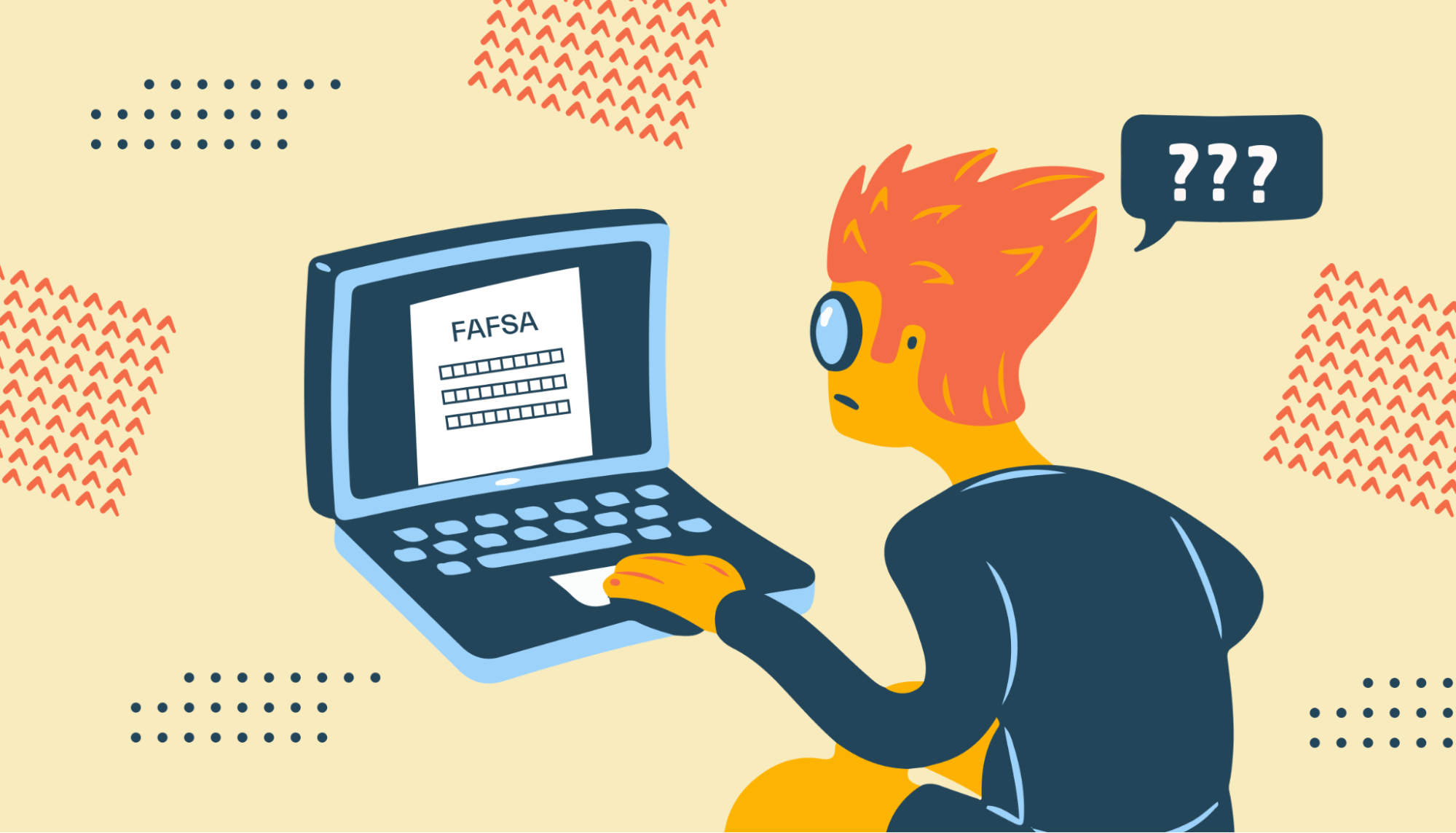
The Free Application for Federal Student Aid (FAFSA) has a lot of questions. One of them may make students stumble—the one about registering with Selective Service.
It’s a weird question to have on the FAFSA. That’s why Congress recently cut it from the application and eliminated your registration status from your financial aid eligibility.
However, Selective Service registration is legally required if you’re eligible, so it's important to know how it works.
Below, we’ll talk more about the Selective Service System, why we have it, and if (and how) you have to sign up. Plus, we’ll discuss the potential penalties for not registering. Even if your financial aid is safe, you’ll see why you should register anyway.
What is Selective Service?
The United States federal government established the Selective Service System in case it felt the need to draft citizens into the military for war.
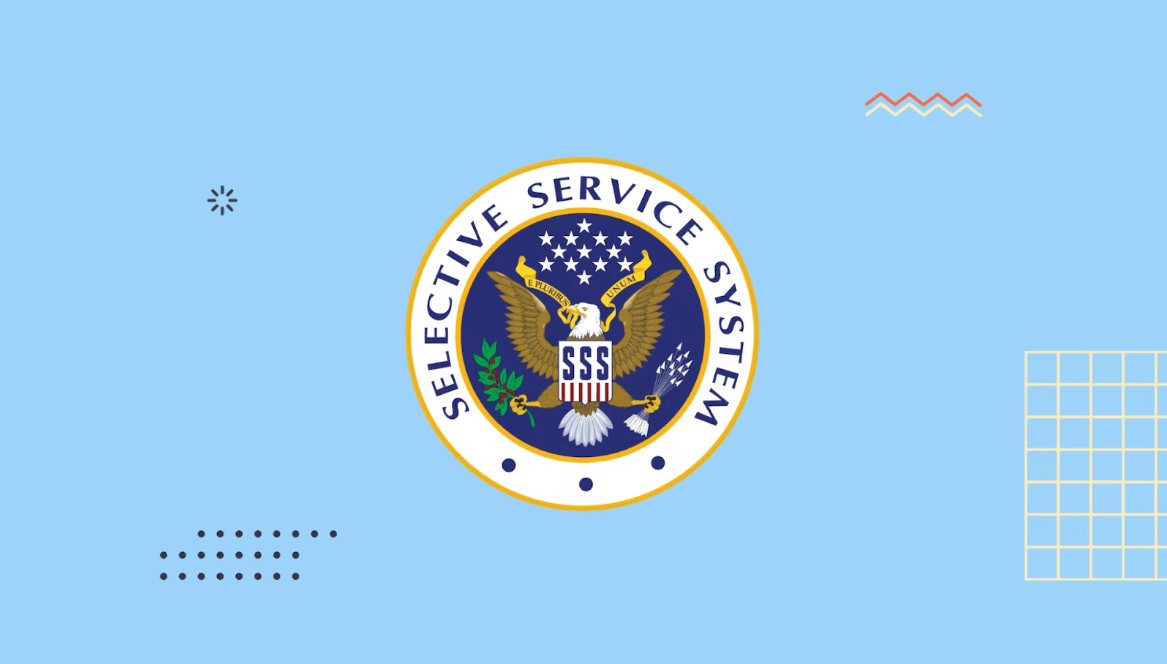
All males between 18–25 (except for people meeting certain exemptions that we lay out later) must register with Selective Service or risk legal consequences.
According to the Selective Service System, this ensures a fair and equitable draft if the government institutes one.
But the question is, why do we have a draft system if there hasn’t been a draft in decades?
A short history lesson reveals the answer:
Why do we have the Selective Service system?
After years of avoiding WW1, the United States officially joined the conflict in 1917 when it declared war on Germany.
However, not enough men volunteered for the armed forces to make the US military a strong fighting force in Europe.
So, Congress passed the Selective Service Act in 1917. This gave the president—Woodrow Wilson at the time—the power to draft soldiers by random lottery.
After WW1, Selective Service drafting continued in small amounts in the United States. It ramped up again for the Korean War, although it exempted men who served in WWII.
Then, drafting ramped up again for the Vietnam War—perhaps the most well-known US military conflict regarding issues surrounding the draft.
The Selective Service registration requirement paused after the Vietnam War ended in 1972. However, President Jimmy Carter reinstated it in 1980 in response to the USSR’s invasion of Afghanistan.
It has remained mostly the same ever since, operating as an independent government agency within the Executive Branch of the federal government. It is not a part of the Department of Defense, even though it seems like it would be.
The US military has been a 100% volunteer force since 1973—there hasn’t been an actual draft since the Vietnam War.
Some discussed reviving the draft for the Iraq War, but most public opinion was against it.
Today, Selective Service registration isn’t enforced too strongly, but there are still severe legal and other consequences for failing to register.
Regardless of arguments for and against it, the system remains in place in case the US needs to expand armed services numbers.
Who has to sign up for the draft?
In general, most men ages 18–25 in the US have to sign up.
This includes male citizens and non-citizen male immigrants. Transgender individuals assigned male at birth but have since changed their gender to female must also register for selective service.
As for the timetable, eligible US citizens must sign up within 30 days of their 18th birthday. Immigrants must sign up within 30 days of entering the US.
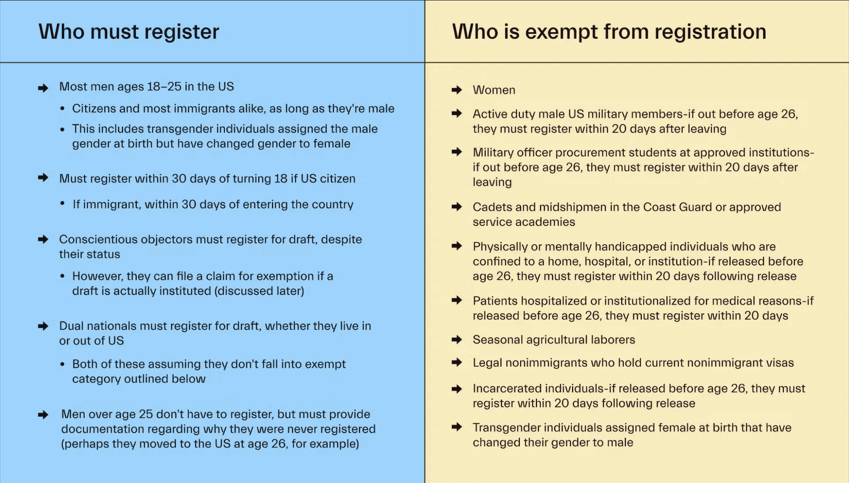
Even if you think the draft is unconstitutional or don’t agree with it, you still have to register with the Selective Service system. However, you can file a claim for exemption if a draft is actually instituted.
Dual nationals must also register for the draft, whether or not they live in the US.
All of this assumes these people don’t fall into any of the exempted categories below.
Exempt groups include:
Women
Active duty male US military members—if out of active duty before age 26, they must register within 20 days after leaving
Military officer procurement students at approved institutions—if out before age 26, they must register within 20 days after leaving
Cadets and midshipmen in the Coast Guard or approved service academies
Individuals with physical or mental disabilities who are confined to a home, hospital, or institution—if released before age 26, they must register within 20 days following release
Patients hospitalized or institutionalized for medical reasons—if released before age 26, they must register within 20 days
Legal nonimmigrants who hold current nonimmigrant visas
Seasonal agricultural laborers
Incarcerated individuals—if released before age 26, they must register within 20 days following release
Transgender individuals assigned female at birth that have changed their gender to male
All that said, women may be required to register in the future.
In 2020, a congressional panel recommended expanding the draft to include women who are 18–25 that don’t fall into other categories listed above (such as having a physical or mental handicap).
International students generally don’t have to register for the draft if they’re in the US on a valid visa, such as an F1 visa—even if they’re a male aged 18-25.
Lastly, men over age 25 don’t have to register. However, if they weren’t registered previously, they must provide documentation regarding why they were never registered. For example, if they moved to the US after their 26th birthday, they’d need to provide paperwork proving that.
Otherwise, they could face the same negative consequences for not registering on time as eligible men who fail to register.
How do I register with the Selective Service system?
You can register online, by mail, or in person. You can no longer use the FAFSA to automatically register.
To register online, you’ll head to the Select Service System’s website and fill out a short registration form by providing your basic personal information. This includes things like your name, address, gender, date of birth, and Social Security number.
That website has a printable registration form with the same general information.
You can also pick up one of these forms at your local post office—if you don’t have a Social Security number, this is the method you should use. You can then fill out the form and drop it off or mail it in.
You should receive an acknowledgment letter and registration card in the mail within 90 days of registering with Selective Service. This is your proof of Selective Service registration, so don’t lose it!
Do I have to register for Selective Service to receive financial aid?
For most of Selective Service’s history, male applicants needed to register to be eligible to receive federal financial aid for college education. Female applicants could disregard Selective Service registration.
If you failed to register by age 26 and you weren’t exempt, the Department of Education disqualified you from most forms of federal aid. That included certain federal student loans, grants, and work-study financial aid programs.
Private student loans, scholarships, and other non-government aid may have still been available to unregistered college students, though some schools required Selective Service registration to enroll.
Parents have never needed to meet this requirement to take out Parent PLUS loans. If they aren’t registered with Selective Service, but you are, your financial aid eligibility is still safe.
In 2020, Congress removed the requirement to register to gain financial aid by passing the FAFSA Simplification Act. This was part of the larger Consolidated Appropriations Act, 2021.
Additionally, FAFSA question 22, which asked about Selective Service registration, was removed starting in the 2023–2024 school year.
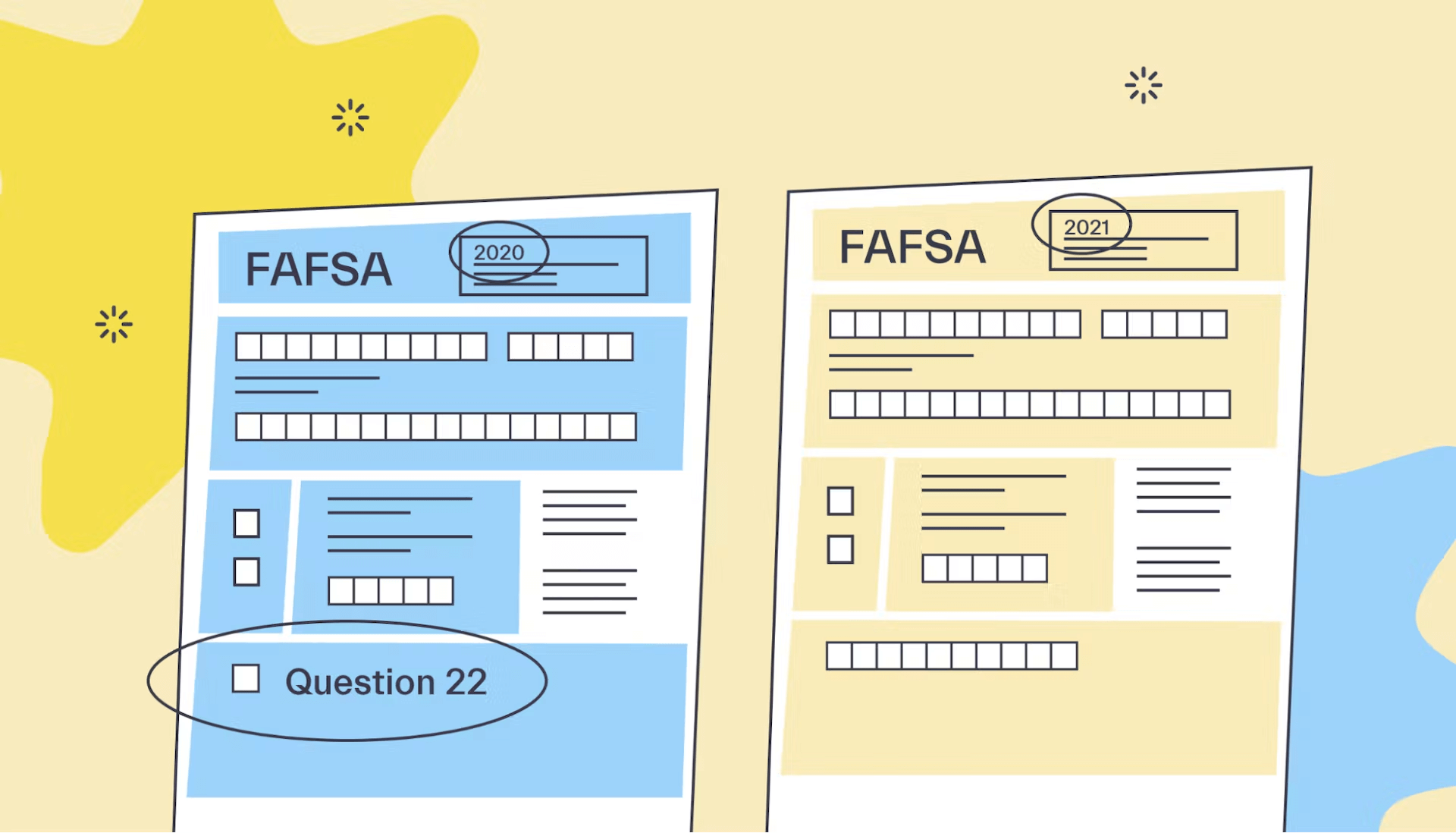
The government also got rid of the restriction on aid for college students with drug convictions, and removed the relevant FAFSA question, Question 23. Both changes shorten the FAFSA application process and potentially allow more students to qualify for financial aid.
Beyond federal aid, though, you still must register with Selective Service if you’re not in an exempt group listed earlier. Otherwise, as we’re about to see, you could face severe legal consequences.
What happens if I don’t register for the draft if I’m not exempt?
Failing to sign up for the draft no longer impacts your financial aid or FAFSA. But if you aren’t exempt, not signing up carries some harsh punishments.
Anyone who fails to register or who “knowingly counsels, aids, or abets another to fail to comply with the registration requirement” faces felony charges—with fines of up to $250,000 and a prison term of up to 5 years.
Legal penalties aren’t often prosecuted nowadays. In April 2019, USA Today stated that only 20 men have ever been criminally charged for failing to register since President Carter’s 1980 reinstatement.
Of those 20, 14 were convicted. The last indictment—which happened in 1986—was dismissed before it could make it to trial.
None of this is to say you should avoid registering, though. It’s the law for now, unless a bill passes to get rid of the Selective Service System.
Plus, failing to register can have other consequences, whether or not you’re punished through the legal system.
For one, registration is mandatory to be eligible for federal government jobs and some state government roles. Plus, various state benefits and privileges—such as driver’s licenses—might require draft registration.
How do I request a Selective Service waiver?
If you believe you should be exempt from registration, you’ll need to prove that to the government by filling out a waiver.
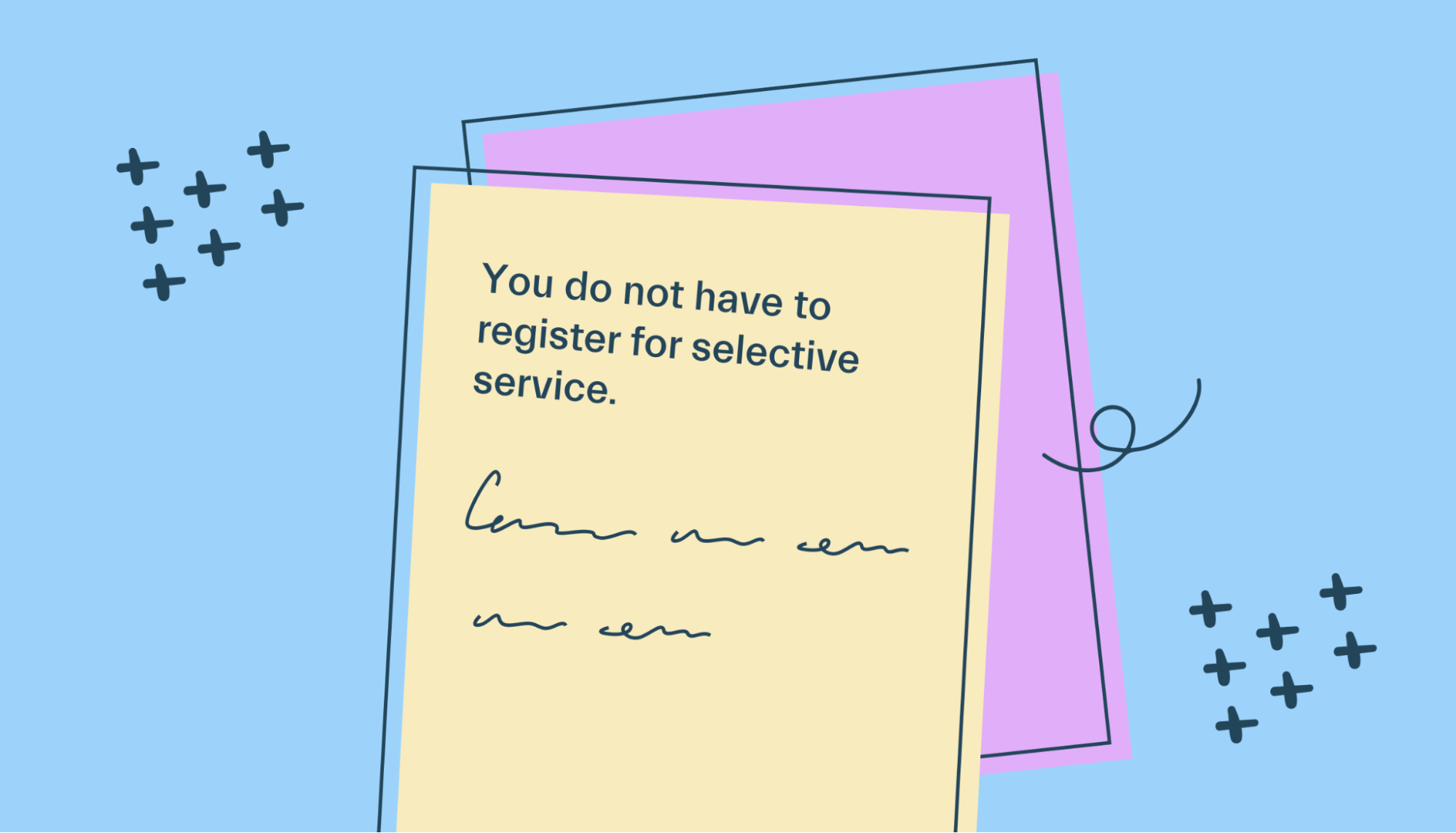
To do so, you’ll need to request a Status Information Letter using the Status Information Letter form on this page of the Selective Service website. You’ll have to provide detailed information on why you’re ineligible, along with copies of supporting documentation (not the originals).
If approved, you’ll get your SIL, which indicates why you weren’t required to register.
Keep the original version of this somewhere safe. Then, you can make copies of it whenever an organization—such as a government employer—needs to know why you never registered.
As for if a draft is actually instituted, Selective Service says that men can file claims for exemptions, postponements, or deferments.
They don’t provide much information on what that looks like, but they would most likely create (or possibly already have created) online and printable forms.
You would submit the claim without evidence—Selective Service would then get back to you with further instructions on what info they need, when they need it, and where to send it.
If your exemption is denied and you’re still selected for military service, you can appeal that to a Selective Service Appeal Board.
Do conscientious objectors have to register for the draft?
A conscientious objector is someone who refuses to bear arms in war and in training based on things like freedom of thought, conscience, or religion.
Conscientious objectors are still legally required to register with Selective Service. However, if a draft is instituted and the conscientious objector is picked, they can file a claim for conscientious objector status.
You’ll have to provide written documentation or have people you know testify about whether you’re truly a conscientious objector.
Per the Selective Service System website:
“Beliefs which qualify a registrant for CO status may be religious in nature but don’t have to be. Beliefs may be moral or ethical; however, a man’s reasons for not wanting to participate in a war must not be based on politics, expediency, or self-interest. In general, the man’s lifestyle prior to making his claim must reflect his current claims.”
If you qualify as a conscientious objector, you may still be drafted into certain roles not involved in combat.
If your beliefs let you serve in the military but restrict you from combat roles, you won’t receive any role or training that involves weapons.
If your beliefs bar you from any military service, Selective Service will place you in the Selective Service Alternative Service Program.
In this program, you’ll be assigned to a civilian job that is “deemed to make a meaningful contribution to the maintenance of the national health, safety, and interest.”
Some examples include jobs in:
Conservation
Education
Healthcare
Youth or elder care
More information can be found on the Selective Service website.
Selective Service: It’s the law, but financial aid rules have changed
Although there hasn’t been a draft since the Vietnam War, Selective Service registration remains a legal requirement if you’re not in an exempt category.
If you’re required to register, it’s a good idea to do so, even if you disagree with the system. They may not enforce the penalties often, but they still could at any time.
However, at the very least, failing to register won’t risk your college financial aid options anymore. Need help understanding exactly what your financial aid options are? Mos can help you apply for scholarships and grants plus, for more answers to your financial aid questions, check out our financial aid FAQs.
Let's get
your money
- Get paired with a financial aid expert
- Get more money for school
- Get more time to do you








